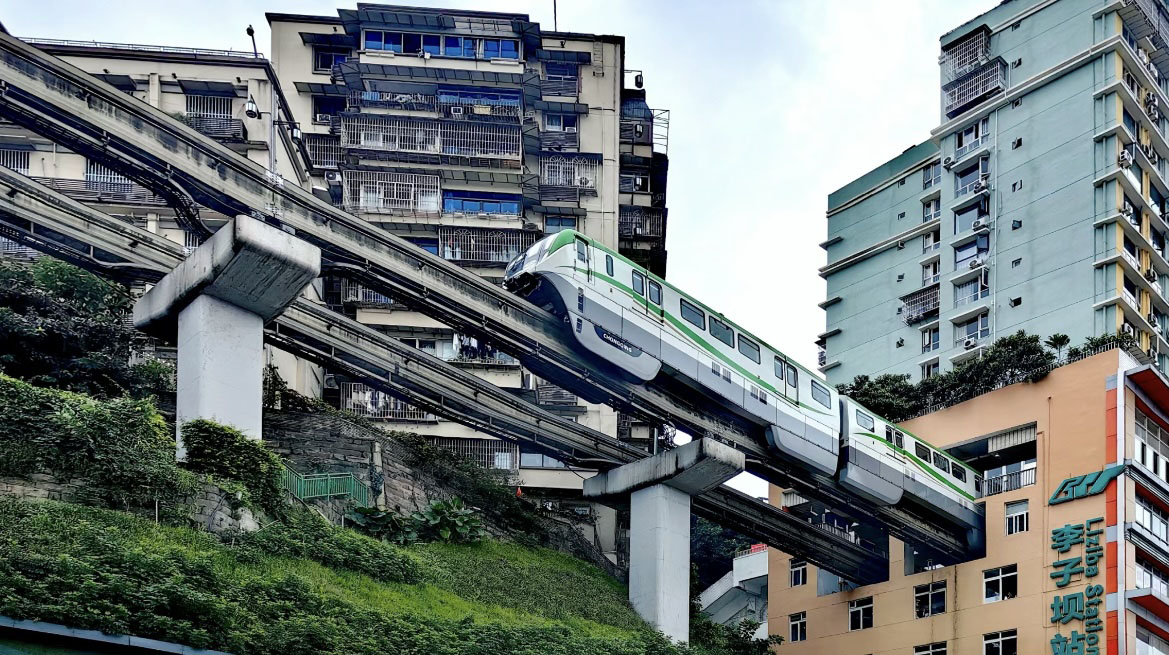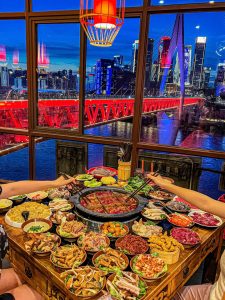Xinlin Tang is an International Student who writes political stories, commentaries and narratives as a Senior Writer for the WORD. Queens is her main focus of attention but she covers other areas.
All Pictures In This Article © copyright Xinlan Tang

The city is located in a hilly area with a humid subtropical monsoon climate. The climate is relatively humid and foggy all year round, so Chongqing is also nicknamed: Fog City
It took hundreds of millions of years for the earth to squeeze out folds to form the valley. This is one of the most typical folded mountainous areas in the world. Each mountain range maintains a certain distance from its next neighbor. This world’s largest parallel mountain city is called Chongqing.
Chongqing is located in southwest China, covering 82,400 square kilometers, and more than 90 percent of the area is mountain land. After many tributaries of the Sichuan Basin merge into the Yangtze River in Chongqing, they create an outlet to connect to the outside world.
As the largest and youngest municipality in China, Chongqing has rich history and culture. During World War II, after the fall of the Nanjing government, Chongqing served as the new political center and capital city to lead the country’s residents in the war of resistance. Due to its special geographical location, Chongqing is surrounded by mountains, the Yangtze River and the Jialing River, making it easy to defend but difficult to attack, forming a natural barrier.
The Japanese army and navy never invaded Chongqing; they relied on air strikes instead.
Angbang is a bamboo stick more than one meter long, which also refers to a group of people. Bangbang is a name reserved for porters in this city. The Chongqing city has an altitude difference of more than 200 meters and is inaccessible to vehicles. As long as you shout “Bangbang” near the freight market, someone should definitely answer you, ‘I’m coming.’ At the most, there are 400,000 Bangbangs who carry their family dreams on their shoulders and measure the changes in this mountain city with their footsteps.

May look like a scene from a sci-fi movie but it’s the real deal: The subway perfectly fits into the terrain of the mountain city. Sometimes it passes by the rooftops, and sometimes it goes through the belly of the building.
In order to adapt to the mountain land and reduce climbing stairs, Chonqingers are masters of utilizing space. They have built various overpasses. Stretched between buildings, the slender overpass connects to the road on the left and to the 13th floor of a residential building on the right. From the first floor to the 13th floor, one can walk on flat ground.
A 66-meter-high overpass draws contour lines in the sky, allowing people on the top floor to enjoy the convenience of being right on the road when they go out. People seek pastoral life from the rooftops. Rice and fish ponds gather on the rooftops, and they can enjoy the joy of harvest without leaving the building. Not only farmland, but also restaurants are moved from the roadside to the roof of the 47th floor. There is not an inch of land to waste in the mountain city, even the vertical cliffs can be utilized.

Eat hot pot when you are happy, eat hot pot when you have been promoted, and eat hot pot when you are heartbroken.
Nearly 600 houses are stacked on top of each other here, not only piecing together a huge commercial street, but also piecing together the most dazzling scenery along the river.
The subway also perfectly fits the terrain of the mountain city. Sometimes it passes by the rooftops, and sometimes it goes into the belly of the building. Let the train go up to the sky and into the earth. At the beginning of the track design, it met a residential building that was about to be built. They hit it off and chose to coexist here. Residents live on the 8th floor above, and the train entrances and exits below the 8th floor.
On average, a train enters the station every 3 minutes, but the people living in the building don’t mind it. They shuttle from downstairs every day, and the train is equipped with pneumatic rubber tires, which reduces noise, and try not to disturb the lives of the neighbors upstairs
Chongqing’s taste base color is bright red. Chongqingnese love spicy food. The city is located in a hilly area with a humid subtropical monsoon climate. The climate is relatively humid and foggy all year round, so Chongqing is also nicknamed: Fog City. Chili pepper can remove moisture from the body and regulate the body health.
Hot pot is a traditional food. It is not only a delicacy, but also a reflection of the spirit and culture of the Chongqing people. It is famous for its spicy, fresh and unique flavor. It uses a seasoning soup base, which is stir-frying of chili, ginger, onion and dozens of spices then add broth, chicken soup and tea and bring it to a rolling boil. Various meat, vegetables and seafood from all over the world, dipped into the sauce.

A steady stream of traffic.
There is a saying in Chongqing: Eat hot pot when you are happy, eat hot pot when you have been promoted, and eat hot pot when you are heartbroken. People here make hotpot a part of their daily lives. People generally like to gather many friends and family together to eat hot pot because the dishes are small and varied, so its good to have a bunch of people to taste different dishes. People chatting and share recent life while holding food on their chopsticks and scalding it in the pot, and holding beer in the other hand.
It is normal for a hot pot meal to last more than three hours. So as soon as you enter a hot pot restaurant, you can immediately blend into a lively, noisy, and laughter environment. In such an atmosphere, what people eat is not only the taste, but the connection and cohesion between people.
In such a fast-paced era, Chongqing is known as one of the cities with the highest happiness index and the slowest pace, which is inseparable from the leisure and entertainment method that best represents Chongqing: playing mahjong, a Chinese board game that originated in 1880 and usually requires four players.
Chongqingers like to play mahjong regardless of their ages, genders, occupations, incomes, or education levels. Whether it is a gathering with family and friends, a leisure time between business negotiations, or even a adjustment between political activities, mahjong is inseparable.
Residents believe that playing mahjong can enhance relationships, enhance trust, increase information and increase income. Mahjong reflects the diversity, vitality and competitiveness of Chongqing society.
Navigating through this urban mountain land while traversing intersecting bridges makes you feel you are existing in a cyberpunk 8D city. The city vividly showcases its ethos of inclusivity, cultural diversity, dynamic energy, and boundless possibilities. It is within such an environment that people of Chongqing have cultivated a spirited ethos and pursuit of life, characterized by tenacity and boldness.
Xinlin Tang can be reached at XINLAN.TANG78@myhunter.cuny.edu